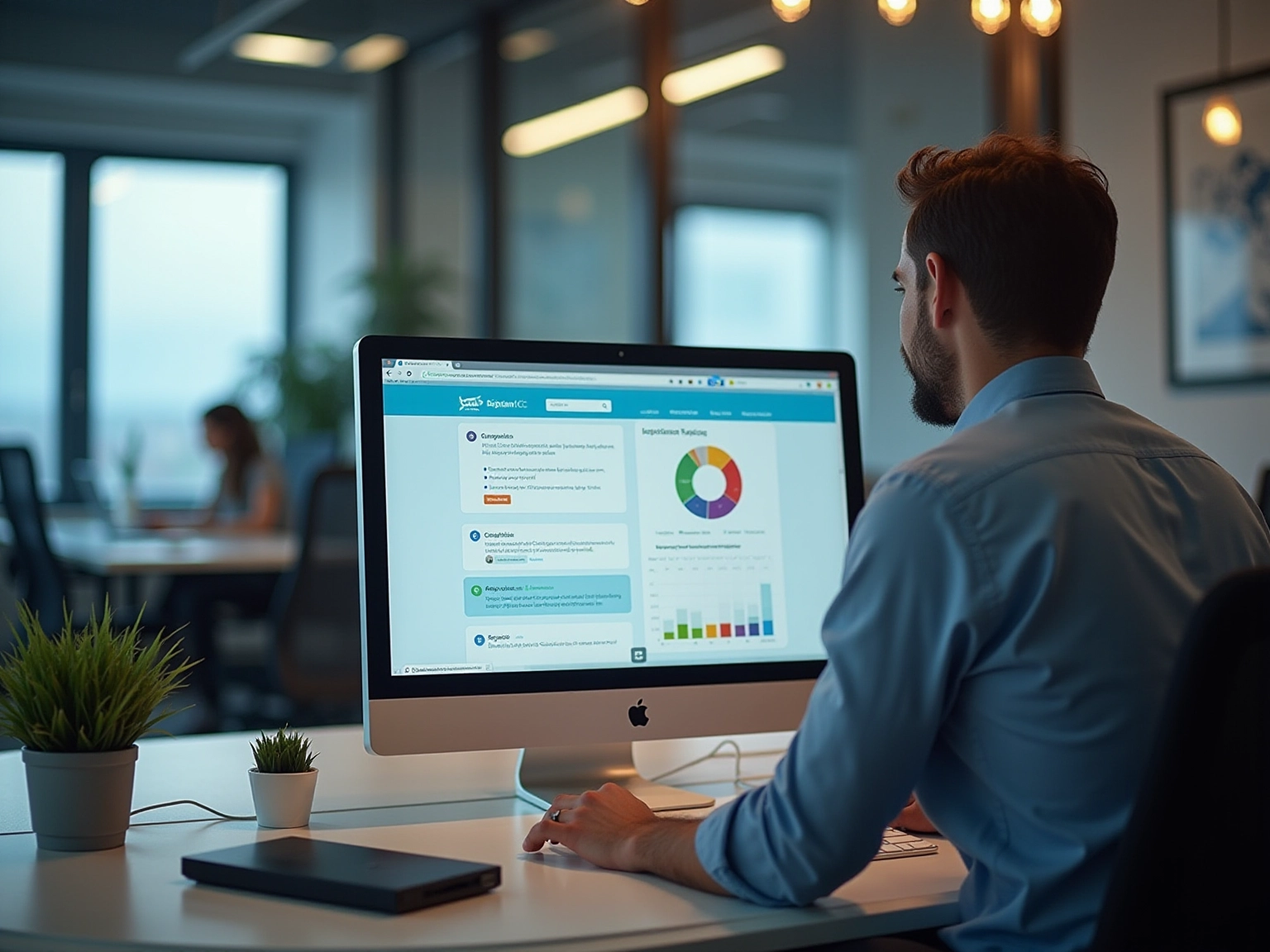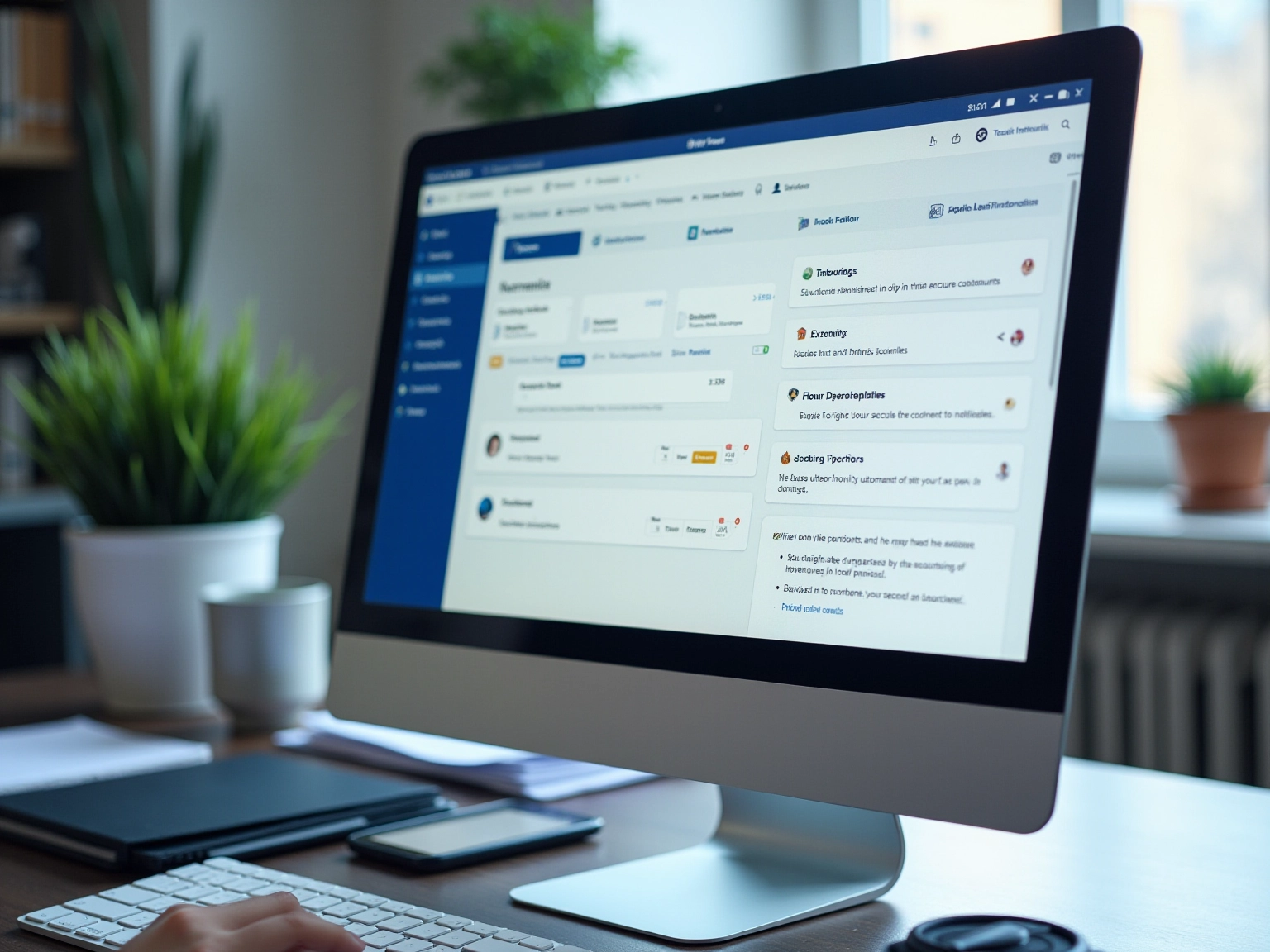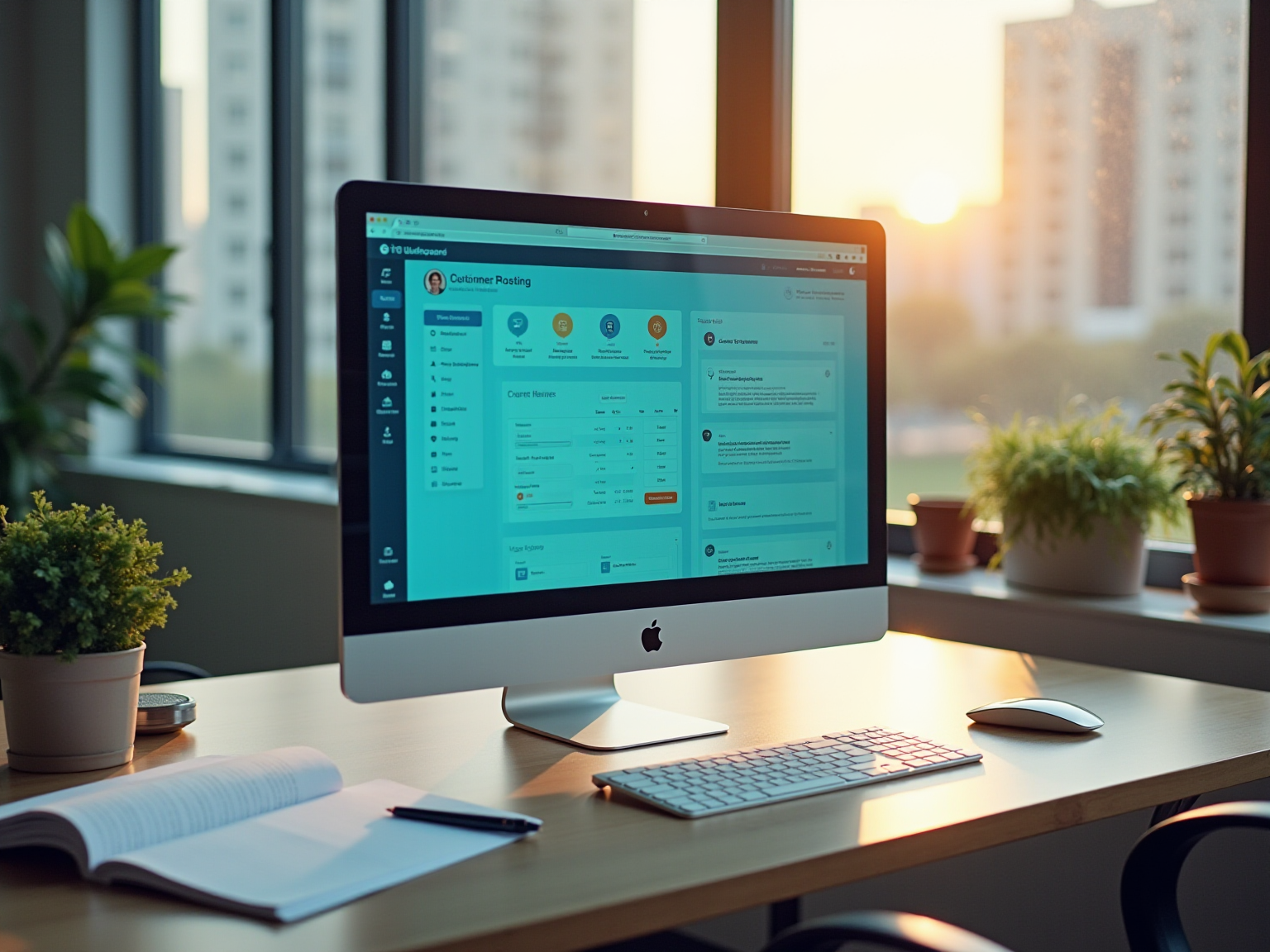Overview
Choosing and implementing customer portal software for an accounting firm is a critical endeavor that requires a thorough assessment of specific needs, the selection of suitable software, and the assurance of effective training and support for staff.
Successful implementation of such systems can lead to remarkable enhancements in:
- Client engagement
- Operational efficiency
- Response times
In fact, firms have reported up to a 50% reduction in response times, alongside substantial time savings, as evidenced by user experiences shared within the content.
This transformation not only streamlines operations but also elevates the overall client experience, underscoring the necessity for accounting firms to invest in robust portal solutions.
Key Highlights:
- Customer portal software serves as a secure online platform for users to manage accounts and documents, improving communication with accounting firms.
- Implementing customer interface software like Glasscubes can alleviate operational inefficiencies and enhance profitability for accountants.
- The use of customer portal software can lead to a 40% increase in response rates and a 50% reduction in response times.
- Features such as secure document sharing, automated notifications, and user-friendly interfaces are crucial for effective customer portal software.
- Customer portals enhance client engagement and operational efficiency by allowing clients to independently manage their accounts.
- Security measures like data encryption, multi-factor authentication, and GDPR compliance are essential for safeguarding sensitive information.
- Successful implementation involves assessing needs, choosing the right software, planning the rollout, training staff, and gathering user feedback.
- Measuring success includes tracking user adoption rates, customer satisfaction scores, response times, and overall engagement with the portal.
- Continuous support and effective training are vital for user adoption and satisfaction with the customer portal software.
Introduction
In the digital age, where client expectations are soaring, accounting firms are leveraging customer portal software as a transformative solution. This innovative technology not only enhances communication but also streamlines operations, empowering firms to manage client interactions with greater efficacy.
With platforms like Glasscubes, firms are witnessing remarkable advancements in efficiency, client satisfaction, and even profitability. As the landscape of client engagement evolves, comprehending the functionalities and benefits of customer portals has become essential for accounting professionals striving to excel in a competitive arena.
This exploration delves into the transformative power of customer portal software and its pivotal role in reshaping the client experience, urging professionals to embrace this essential tool for success.
Understanding Customer Portal Software: A Primer
Customer portal software serves as a secure online platform that empowers users to access their accounts, manage documents, and communicate seamlessly with their accounting agencies. Acting as a centralized hub for customer interactions, these platforms facilitate effective information exchange and significantly enhance customer engagement. By adopting customer interface software like Glasscubes, accounting firms can streamline workflows, reduce reliance on traditional communication methods such as email, and ultimately elevate customer satisfaction.
In 2025, the advantages of customer interface software for accountants are more pronounced than ever. With 63% of accountants reporting decreased profitability due to rising operational expenses, implementing a customer interface like Glasscubes emerges as a strategic decision to alleviate these challenges. These platforms not only improve communication but also foster a more structured approach to customer management, addressing the operational inefficiencies that contribute to diminished profitability.
The benefits of customer portal software extend beyond mere convenience. They enable accounting firms to automate reminders and monitor customer requests in real-time, leading to an impressive 40% increase in response rates and a 50% reduction in response times. For instance, companies utilizing this software have reported significant time savings; Sophie Montgomery from TaxAssist Accountants noted an astounding 288 hours saved in a single tax season.
This efficiency translates into stronger relationships with customers and enhanced operational effectiveness.
Industry leaders underscore the importance of customer engagement through these platforms, revealing that 40% of new employees choose a practice based on its reputation. By improving customer communication and satisfaction, customer portal software can significantly bolster a company’s reputation, making it more attractive to prospective employees. As businesses increasingly recognize the value of customer portal software, successful implementations are becoming more prevalent, showcasing the transformative impact these tools can have on client engagement and overall business performance.
In summary, customer software such as Glasscubes is not merely a technological upgrade; it is a vital component for accounting firms aiming to enhance their operational efficiency and strengthen client relationships. By understanding the features and benefits of these platforms, companies can position themselves for success in an increasingly competitive landscape.

Key Benefits of Customer Portal Software for Accounting Firms
Customer portals represent a pivotal advancement in accounting, serving as a centralised platform for real-time communication that significantly reduces the reliance on back-and-forth emails. This streamlined approach guarantees that customers receive timely updates, fostering a more responsive relationship. As Nelson Boswell aptly stated, “Here is a simple but powerful rule: always give people more than what they expect to get,” underscoring the importance of exceeding customer expectations.
The experience shared by Steve, an audit manager at MGI, exemplifies this transformation. He noted that prior to leveraging the platform, the audit process was mired in extensive email communications, often leading to lost information and misunderstandings among team members. However, since adopting the platform, users have engaged thoroughly, and the clarity of having all information in one location has markedly enhanced communication.
Clients now enjoy the ability to log into the platform to view outstanding queries and necessary documents, resulting in faster responses and a more structured workflow.
With secure upload and access features, users can effortlessly organise their documents within the platform. This not only streamlines the information-gathering process but also minimises the risk of lost files, thereby enhancing overall efficiency.
The incorporation of automated reminders and notifications within the platform empowers accountants to manage customer requests with increased efficiency. Companies utilising customer portal software like Glasscubes have experienced an impressive 50% reduction in response times, illustrating the effectiveness of these tools in enhancing customer interactions. This automation conserves valuable time and reduces the need for manual follow-ups, allowing firms to concentrate on higher-value tasks.
A user-friendly interface enables customers to manage their accounts with ease, resulting in an improved overall experience. Personalisation in customer service significantly bolsters customer loyalty and trust, which are crucial for retention. Organisations that prioritise customer experience through effective system implementation have witnessed substantial returns; for instance, companies excelling in customer service report 41% quicker revenue growth compared to their competitors, highlighting the financial benefits of investing in consumer engagement solutions.
Customer portals prioritise security, ensuring that sensitive financial data is managed in compliance with GDPR and other regulations. This commitment to data security cultivates trust with customers, who can feel confident that their information is safeguarded.
In summary, the transformative experiences shared by users of this platform underscore the tangible benefits of integrating such technology into accounting practices, yielding significant time savings and enhanced customer response rates.

Must-Have Features in Customer Portal Software for Accountants
-
Secure Document Sharing: The secure sharing of sensitive documents is paramount for accounting firms. To protect customer information from unauthorized access, companies utilise customer portal software equipped with robust encryption and access controls. This is essential for maintaining customer trust and complying with regulations such as GDPR. Firms adopting customer portal software have reported a remarkable 50% reduction in response times, showcasing how secure document sharing enhances customer interactions.
-
User-Friendly Interface: An intuitive and straightforward design is critical for promoting user adoption. The company offers an interface that allows users to navigate the portal effortlessly, leading to improved engagement and satisfaction. This ease of use resembles email but without the limitations, making it a practical choice for users.
-
Integration Capabilities: Seamless integration with existing accounting software is crucial. The customer portal software improves data management and streamlines workflows, enabling firms to operate more efficiently while preserving established processes.
-
Automated Notifications: Automated notifications for document submissions and deadlines can significantly boost user responsiveness. ‘Glasscubes’ automated reminder feature allows companies to send an unlimited number of reminders with customizable messages, ensuring recipients are informed of critical tasks and deadlines. The basic option permits up to 10 reminders on a straightforward schedule, while advanced options facilitate unlimited reminders with any frequency or specific days of the year. This functionality can lead to a 40% increase in responses to customer inquiries when utilising customer portal software.
-
Mobile Accessibility: In today’s fast-paced environment, a mobile-friendly portal is increasingly vital. The company ensures that users can access their information anytime, anywhere, enhancing convenience and fostering greater engagement.
-
Expert Insights: Accounting professionals underscore the importance of these features in enhancing customer interactions. For instance, Krista Black, a content marketer, asserts that ‘customer portal software with a feature-rich interface can revolutionise how companies manage customer relationships,’ highlighting the significance of strong features akin to those offered by a specific platform.
-
Case Studies: Successful implementations, such as Ahsuite, illustrate the effectiveness of secure document sharing and project management tools tailored for specific industries. While Ahsuite focuses on digital agencies, its principles of secure communication and efficient document handling are applicable to accounting practices, ensuring sensitive information is shared securely and effectively.
-
Importance of Secure Document Sharing: Within the accounting sector, secure document sharing is not merely a feature; it is an essential requirement. The risk of data breaches necessitates that firms adopt customer portal software solutions that prioritise security, safeguarding customer information and ensuring privacy.
-
Examples of Secure Document Sharing: Leading customer portal software solutions, such as Glasscubes, integrate features like encrypted file transfers and secure access protocols, which are crucial for maintaining user trust and adhering to regulations like GDPR.

Exploring Different Types of Customer Portals: Which One is Right for You?
Accounting firms are increasingly leveraging customer portal software to enhance engagement and optimise operations. Understanding the main categories of these solutions is essential for maximising their benefits:
-
Customer Access Points: These platforms are specifically designed for direct interactions with clients, enabling seamless document sharing, communication, and task management. This ensures that accountants and customers can collaborate effectively. Companies utilising customer portal software, such as Glasscubes, have reported significant improvements in efficiency and customer satisfaction, attributed to features like automated reminders and organised responses that prevent vital information from being lost in busy inboxes. Moreover, Glasscubes is secure, encrypted, and GDPR compliant, providing peace of mind for both businesses and clients. Case studies highlight enhanced customer relationships and a modern brand image fostered by these tools. The self-service nature of customer portal software allows clients to manage their accounts independently, dramatically reducing the workload for accounting staff. By facilitating customer access to their information and enabling them to complete tasks without direct assistance, companies can achieve greater efficiency and satisfaction. The implementation of such software has been shown to cut response times by up to 50%, allowing firms to manage workloads more effectively.
-
Customer Portal Software: This is particularly beneficial for organisations engaged in project-based work with clients, as it promotes real-time collaboration and feedback. The application enhances this experience by providing visual progress reports that keep all parties informed, coupled with a comprehensive response system that ensures communication is structured and easily accessible.
-
Mobile Interfaces: Designed for accessibility, these interfaces empower customers to engage with their accounting services anytime and anywhere, ensuring that crucial tasks can be completed on the go. Integrated solutions, including customer portal software, amalgamate various functionalities such as customer relationship management (CRM) and project management into a single platform. This integration simplifies processes and enhances overall service delivery, facilitating improved customer engagement.
By choosing the right customer portal software, accounting organisations can significantly boost operational efficiency while enhancing the customer experience. For instance, Sophie Montgomery of TaxAssist Accountants noted an impressive saving of 288 hours in a single tax season, underscoring the tangible benefits of utilising efficient client platforms like Glasscubes. The adoption of customer portal software can yield substantial advantages for accounting firms, ultimately enhancing service provision.

Ensuring Security and Compliance in Customer Portal Solutions
Safety and adherence are paramount when selecting and implementing customer portal software solutions for accounting firms. To safeguard sensitive customer information, organisations must prioritise the following key measures:
- Data Encryption: All data transmitted through the interface must be encrypted. This critical step protects against unauthorised access and ensures the confidentiality of customer information.
- User Authentication: The implementation of multi-factor authentication significantly bolsters security. This approach guarantees that only authorised users can access sensitive data, thereby mitigating the risk of data breaches. Firms leveraging Identity and Access Management (IAM) benefit from enhanced control over user access, streamlined monitoring of authentication policies, and improved security through effective management of user identities.
- Regular Security Audits: Conducting periodic security audits is essential for identifying system vulnerabilities. These audits not only ensure compliance with industry regulations but also strengthen the overall security posture of the firm.
- GDPR Compliance: Adherence to GDPR guidelines is non-negotiable. The customer portal software must align with regulations governing data handling and customer consent, which is vital for maintaining trust and legal compliance in the digital landscape.
- Access Controls: Role-based access controls are crucial for regulating who can view or edit specific information. This strategy minimises the risk of data breaches by ensuring that only authorised personnel have access to sensitive data.
- Cookie Management and Privacy Policies: Effective cookie management and transparent privacy policies are integral to enhancing user experience and data security. By informing users about how their data is collected and utilised, companies can foster trust and ensure adherence to privacy regulations. This transparency is essential for sustaining customer confidence in the protection of their information.
Integrating these security strategies not only protects customer data but also enhances the organisation’s reputation in an increasingly digital environment where cybersecurity is a primary concern for UK accounting practices. Recent statistics indicate that companies adopting robust security measures can achieve a 50% reduction in customer response times. Moreover, testimonials from users such as Sophie Montgomery of TaxAssist Accountants, who reported an impressive 288 hours saved in a single tax season, illustrate the time efficiency gained through effective security measures and user engagement.
This underscores the notion that security and efficiency can indeed coexist.
Implementing Customer Portal Software: A Step-by-Step Guide
To implement customer portal software successfully in your accounting firm, adhere to these essential steps:
-
Assess Your Needs: Begin by identifying the specific requirements of your firm and your customers. This evaluation will assist you in pinpointing the essential attributes for your platform, ensuring alignment with both operational objectives and client expectations.
-
Choose the Right Software: Conduct thorough research to compare various customer access solutions. Consider factors such as functionality, budget, and scalability. Seek software that not only satisfies your current requirements but also possesses the capability to expand alongside your business.
-
Plan the Implementation: Develop a comprehensive implementation plan that outlines the timeline, required resources, and responsibilities. This structured approach will streamline the process and ensure that all team members are aligned on their roles. For instance, before fully launching the Glasscubes platform, a live pilot account will be tested with key stakeholders and a small group of clients to gather feedback and make necessary adjustments.
-
Customise the Platform: Adapt the platform to reflect your company’s branding and operational requirements. Customisation enhances user experience and guarantees that the platform functions as a genuine representation of your firm’s identity. Client portals provide practical access to personal data and documents from any device with an internet connection, moving away from traditional communication methods—an essential evolution as businesses grow. Additionally, the automated reminder feature of Glasscubes allows you to send up to 10 reminders on a simple schedule, or an unlimited number of reminders with any frequency or on specific days of the year. You can also personalise the messages for each reminder, ensuring timely communication with customers.
-
Train Your Team: Provide extensive training for your staff to ensure they are proficient in using the new system. This training should address not only the technical components of the platform but also how to support customers effectively, fostering a smooth transition.
-
Initiate and Oversee: Deploy the platform to your customers and actively track its utilisation. Gather feedback to identify areas for improvement and make necessary adjustments. This iterative process is crucial for optimising the portal’s effectiveness and improving user engagement. As emphasised by Sophie Montgomery of TaxAssist Accountants, “Before implementing this platform, our entire team was engaged in reaching out to our customers several times each year to ask for their records.” This was very time-consuming and not as successful as we would have liked. We started using Glasscubes this tax year, and to date, it has saved us around 288 hours of resource, allowing our staff to focus on actual work.
Establishing a customer interface can greatly enhance customer interactions and operational efficiency. Companies that have implemented such solutions report significant time savings and improved customer response rates. By following these steps, your firm can fully leverage customer portal software, ultimately driving success and fostering stronger customer relationships.
Discover how we transform customer engagements in just 4 minutes! Watch our on-demand demo to see how we streamline information gathering: Get quicker, higher-quality responses from customers. Avoid workload bottlenecks and delays. Save hundreds of hours of effort.
Where should we send the link? Submit. Join companies like Menzies that have experienced a 40% enhancement in customer response times.
Prefer a tailored experience? Click here to schedule a personalised demo with one of our Product Specialists.

Overcoming Implementation Challenges: Tips for a Smooth Transition
Implementing customer portal software can present challenges; however, with the right strategies, these can be effectively managed. Essential tips to facilitate a successful transition include:
-
Engage Stakeholders Early: Involving key stakeholders from the outset is crucial. This ensures that their needs and concerns are integrated into the planning process, fostering a sense of ownership and commitment to the new system. Research suggests that establishing trust with stakeholders can result in a 10% improvement in employee retention in technology, emphasising the significance of engagement during the implementation phase.
-
Communicate Clearly: Keeping open lines of communication with both staff and customers throughout the implementation phase is essential. Clear communication helps manage expectations and reduces resistance to change, which is often a significant barrier in software transitions.
-
Provide Ongoing Support: Continuous support is essential for user adaptation. Offering resources such as FAQs, troubleshooting guides, and dedicated support teams can significantly ease the transition and enhance user confidence in the new system.
-
Gather Feedback: Regularly soliciting feedback from users allows for the identification of areas needing improvement. This iterative process not only enhances the user experience but also demonstrates a commitment to meeting stakeholder needs. For instance, Steve, an audit manager at MGI, observed that since utilising the platform, customers have engaged thoroughly with it, resulting in faster responses and enhanced transparency in the audit process. He mentioned that customers value the ability to access the platform and view pending inquiries and necessary details, which has greatly improved communication. The features of Glasscubes, such as automatic reminders and a centralised workspace, have been particularly beneficial in this regard.
-
Be Patient: Transitioning to a new system is a process that requires time and understanding. Being ready to tackle problems as they arise during the initial launch can help reduce frustrations and foster trust among users.
Incorporating these strategies can lead to a more seamless implementation process, ultimately improving user engagement and satisfaction. Companies that have effectively overcome these challenges, such as MGI, report notable enhancements in customer response rates and overall efficiency. The positive feedback from clients about having a secure workspace for all information and queries underscores the transformative impact of Glasscubes on audit efficiency and client engagement. By prioritising stakeholder involvement and communication, accounting firms can maximize the advantages of their customer portal software solutions.

Training and Support: Key to Successful Adoption of Customer Portals
-
Effortless Onboarding Experience: Implementing effective training sessions is crucial for the successful adoption of customer software. With Glasscubes, however, the onboarding process is remarkably straightforward. No training is required, as our team expertly handles the initial setup during a personalised onboarding call. This 30-minute session allows us to fully understand your team structure and workflows, ensuring a customised experience that encourages immediate interaction with the platform. During this call, we also address any concerns regarding client engagement and ease of use, which have been effectively managed throughout our transition to Glasscubes.
-
User-Friendly Resources: To facilitate ease of use, we create a suite of accessible resources, including straightforward guides, instructional videos, and frequently asked questions (FAQs). These materials are readily available for users to refer to as needed, fostering independence and confidence in navigating the site. Given that 52% of consumers express interest in AI that assists them during their experience, it is essential that these resources are intuitive and user-friendly.
-
Ongoing Support: Establishing a robust support system is essential for addressing user inquiries and technical issues. This may involve a dedicated helpdesk, online chat support, or a comprehensive knowledge base, ensuring users have access to assistance whenever they encounter challenges. Research indicates that 88% of customers are more likely to remain loyal if they experience minimal frustration during service interactions, underscoring the necessity of continuous support.
-
Encourage Feedback: Cultivating a culture of open communication is vital. We motivate users to share their experiences and feedback regarding the platform and training programmes. This input is invaluable for refining our training methods and enhancing the system’s functionality, ultimately leading to a more effective user experience. A case study on personalisation in customer experience highlights that nearly half of customers (49%) are more likely to return after a personalised experience, emphasising the importance of tailored training and support in retaining customers using customer portal software. Effective training programmes significantly enhance user adoption rates; firms that invest in tailored training see marked improvements in user engagement and satisfaction. Furthermore, ongoing support is critical; studies show that 88% of customers are more likely to remain loyal if they experience minimal frustration during service interactions. This highlights the importance of ongoing assistance in ensuring that accounting professionals can fully leverage the functionalities of their customer portal software. As noted by Sophie Montgomery from TaxAssist Accountants, effective training can lead to substantial time savings, exemplifying the benefits of a well-implemented training and support system.

Measuring Success: Evaluating the Impact of Your Customer Portal
To effectively measure the success of your customer portal, it is essential to focus on several key metrics:
- User Adoption Rates: Assess the percentage of clients actively utilising the portal against the total client base. High adoption rates suggest that users perceive the platform as valuable and easy to navigate.
- Customer Satisfaction Scores: Gather feedback through surveys or direct inquiries to assess customer satisfaction levels with the portal. Metrics such as Customer Satisfaction Score (CSAT) can provide insights into user experience and areas for improvement. Furthermore, comprehending metrics such as Average Resolution Time (ART) can further improve the assessment of customer satisfaction.
- Response Times: Monitor the speed at which users can submit requests and receive replies. A significant reduction in response times—up to 50% for firms using effective portal solutions like Glasscubes—can highlight the portal’s efficiency and its impact on client interactions. This is especially pertinent for accountants who formerly dealt with extensive email threads and misplaced information, as this solution simplifies communication and minimises redundancy. As one user mentioned, “The shift to the new platform has drastically reduced the back-and-forth emails that used to clutter our communication.”
- Document Management Efficiency: Measure the time saved in managing documents compared to traditional methods. This can encompass assessing the simplicity of uploading, accessing, and sharing documents via the platform, which tackles the challenges of handling information through emails. One accountant shared, “Before Glasscubes, we often lost track of important documents in lengthy email threads. Now, everything is organised and easily accessible.”
- Overall Engagement: Examine user interaction with the system, including login frequency and the number of actions performed within the platform. Elevated engagement rates indicate that users are finding the platform advantageous for their requirements.
Incorporating insights from customer service metrics can provide a broader context for assessing the system’s effectiveness. As highlighted in the case study “Key Takeaways on Customer Service Metrics,” understanding these metrics can lead to improved customer retention and service quality. By systematically assessing these metrics, accounting companies can acquire valuable insights into the effectiveness of their customer software, ultimately resulting in enhanced client engagement and satisfaction.
As Kuzma Safonov, CTO at FuseBase, emphasises, “Metrics are essential for understanding the impact of technology on customer interactions.” Moreover, efficient customer interface software can positively impact Average Revenue Per Account (ARPA), connecting the system’s success to improved profitability.
Next Steps: Choosing and Implementing Your Customer Portal Software
When considering the implementation of customer portal software for your accounting firm, it is essential to follow a structured approach to ensure success:
- Conduct a Needs Assessment: Begin by evaluating your firm’s specific requirements and customer expectations. This assessment will help you identify the features that are most critical for your operations and client interactions.
- Research Options: Explore various solutions available in the market for customer portal software. Compare their features, pricing structures, and user reviews to find the best fit for your firm. It is crucial to search for platforms that provide mobile optimisation, as this is becoming increasingly important for attracting millennial customers who prefer accessing services through their smartphones. For instance, this platform offers a user-friendly interface that caters to this demographic while ensuring secure, GDPR-compliant communication. Moreover, Glasscubes provides automated notifications and real-time insight across all users, significantly enhancing your information collection process.
- Engage Stakeholders: Involve key team members in the decision-making process. Their insights will be invaluable in addressing potential concerns and ensuring that the chosen solution meets the needs of all users within the firm.
- Plan for Implementation: Develop a comprehensive implementation plan that outlines timelines, responsibilities, and training schedules. This plan should also incorporate strategies for onboarding clients to the new platform, ensuring a smooth transition. Glasscubes offers dedicated onboarding assistance to facilitate this process.
- Launch and Monitor: Once the gateway is initiated, continuously observe its performance. Collect feedback from both customers and staff to determine areas for enhancement. This iterative process will help you make necessary adjustments and enhance the overall user experience. Companies utilising platforms like these have reported a 40% rise in customer response rates and a 50% decrease in response times, demonstrating the potential advantages of a well-executed customer portal.
Support Packages: Glasscubes provides different support packages to enhance customer engagement, including Bronze, Silver, and Gold plans, with pricing beginning at £1,500 annually. Each package offers various levels of support, ensuring that your business has the assistance it requires.
By following these steps, accounting companies can effectively select and implement customer portal software to streamline communication and significantly enhance customer engagement. As James Rose noted, “According to recent market analysis, revenues for accounting firms have increased by 15% after switching to cloud accounting solutions,” further emphasising the positive impact of adopting modern technology in accounting practices. For those interested in exploring Glasscubes further, watch our on-demand demo to see how we streamline information gathering and enhance client engagement.
Where should we send the link? Submit.

Conclusion
Embracing customer portal software like Glasscubes represents a pivotal shift for accounting firms aiming to enhance client engagement and operational efficiency. The advantages of such platforms are numerous, including:
- Streamlined communication
- Reduced response times
- Improved document management
All of which contribute to heightened client satisfaction and increased profitability.
As firms confront the complexities of the digital era, implementing customer portals becomes not just beneficial but essential. By offering secure, user-friendly interfaces that enable real-time interactions and automate processes, these tools empower both accountants and clients alike. The evidence is compelling: substantial time savings, elevated response rates, and a more organised workflow highlight the transformative potential inherent in adopting customer portal solutions.
Ultimately, the integration of customer portal software transcends a mere technological upgrade; it emerges as a strategic necessity for accounting firms striving to excel in a competitive environment. Firms that acknowledge and leverage the power of these tools position themselves for enduring success, enhancing their reputation while attracting both clients and top talent. The future of client engagement is undeniably digital—embracing it is the key to unlocking greater efficiency and satisfaction within accounting practices.
